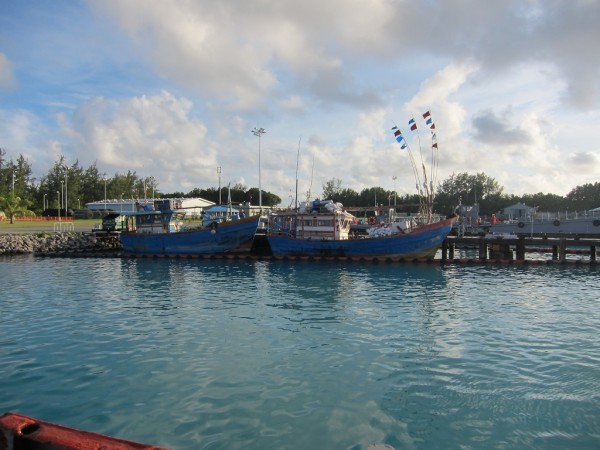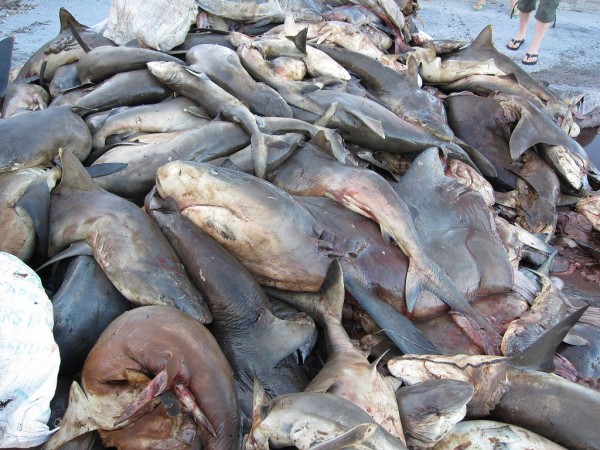Enforcing the world’s largest marine reserve
Last week the Greenpeace vessel the Rainbow Warrior sighted and boarded three Sri Lankan fishing vessels within the Chagos marine reserve. Two of these vessels were almost certainly fishing illegally and are not listed by the fisheries management body for the Indian Ocean, the Indian Ocean Tuna Commission (IOTC). Greenpeace found piles of dead sharks in one vessel, and skipjack tuna in the other. The third vessel is registered by the IOTC to fish on the high seas, and did not allow Greenpeace to board, so it is not possible to say whether they were engaged in illegal activity despite being within the MPA (Marine Protected Area) which is a strictly ‘no take’ zone.
Enforcement of the Chagos marine reserve is one of the biggest challenges we face, as it is for marine reserves, licensed fisheries and indeed for all areas of the ocean, not just protected areas. By conservative estimates, illegal and unreported fishing accounts for one fifth of the world’s annual catch, and is worth up to US$23.5 billion in lost revenue to the global economy. Some illegal or unregulated vessels are known to have changed flags up to seven times and names up to nine times in an attempt to escape scrutiny. In Chagos, an especially difficult area to police given it covers and area larger than France, reef shark populations declined by 90 percent thanks to illegal fishing in the 30 years before the marine reserve was established.
Understandably, it is unwise, on general security grounds, for the BIOT administration to provide details about how and when BIOT’s patrol vessel the Pacific Marlin patrols the Chagos marine reserve, not least because it would give information to prospective poachers.
However, we do know that the Pacific Marlin patrols the marine reserve almost full-time all year, and that since the marine reserve was designated in April 2010, the number of apprehensions of illegal vessels within the area has increased. Around twelve vessels were arrested and prosecuted in both 2011 and 2010. All of the illegal vessels captured have been Sri Lankan, similar in size and appearance to those accosted by Greenpeace last week. The below photos are a typical example, from an apprehension made in February 2012.

Sri Lankan fishing vessels captured by the Pacific Marlin in February 2012 (c) Charles Sheppard

Dead sharks seized from an illegal vessel captured by the BIOT patrol vessel, Pacific Marlin, in February 2012 (c) Charles Sheppard
Unfortunately, the Pacific Marlin is the only vessel available to the BIOT Administration to support the protection of the Chagos archipelago. It has numerous duties and therefore cannot be allocated to enforcement of the marine reserve at all times. Following urging from the Chagos Conservation Trust and partner NGOs in the Chagos Environment Network, as well as MRAG, this year for the first time the BIOT administration have engaged the use of surveillance cameras to look for possible illegal fisheries activity within the marine reserve. This will provide much-needed additional coverage to monitor and enforce the protected area.
In addition, those mooring their yachts at Chagos have found that the rules have been strengthened considerably since the marine reserve was put in place. On 1st May this year a couple of “yachties” boasted on their blog about cooking and eating rare coconut crabs whilst moored at Salomans atoll in the north of the archipelago – an activity that is strictly prohibited throughout the territory. By 4th May they had been evicted from the marine reserve.
Those transiting the Indian Ocean find the northern islands of the Chagos archipelago a useful place to moor for a few days, but before the marine reserve was created many people had abused this situation and stayed for many months every year. This situation has changed dramatically, and visitors are now permitted to spend a maximum of just 28 days in the territory and the fee for a permit has been increased to £50 per week, up from £100 per month. There are also stricter rules around the quantity of fish that can be taken for sustenance, which is now limited to three-day’s worth. These new restrictions mean that there are fewer visitors to the Chagos marine reserve, who stay for less time, leave less pollution and take fewer fish. This can only be a good thing for the long term health of the marine environment.
Monitoring and enforcement of any large area such as the Chagos marine reserve will always be a difficult task, and we are grateful to our friends at Greenpeace for accosting the illegal vessels and reporting them to the authorities. However, care should always be taken not to do anything which might prejudice subsequent legal proceedings. At the Chagos Conservation Trust we are encouraged by the progress that has been made on monitoring and enforcement so far, but believe it does not go far enough. We will continue to work with the BIOT administration, Greenpeace and other NGOs to strengthen monitoring and enforcement of the Chagos marine reserve to ensure that this unique and extraordinary environment is protected for the benefit of those who rely on the Indian Ocean for sustenance and livelihoods now, in the future, and for the health of the entire ocean for all of humanity.

